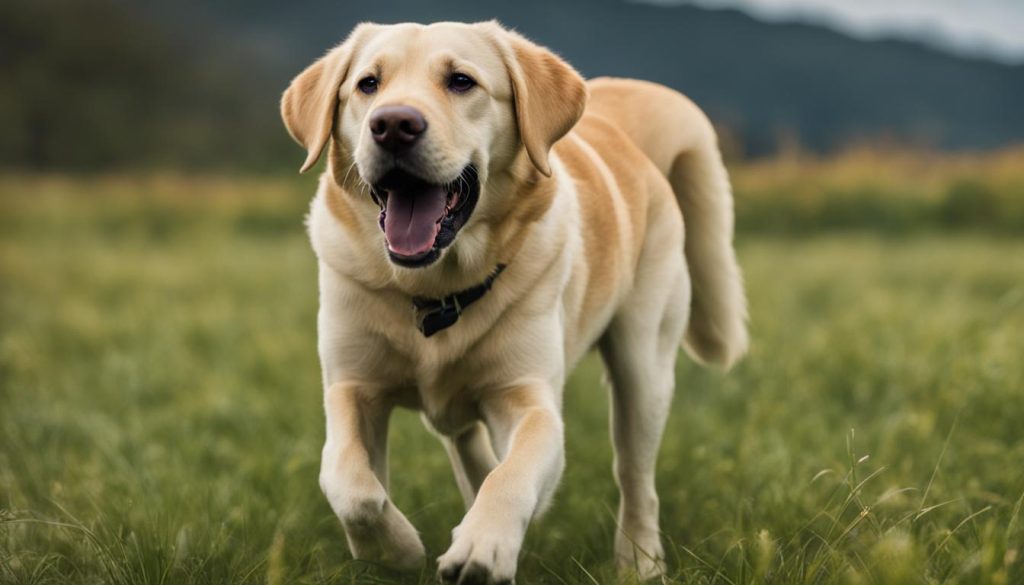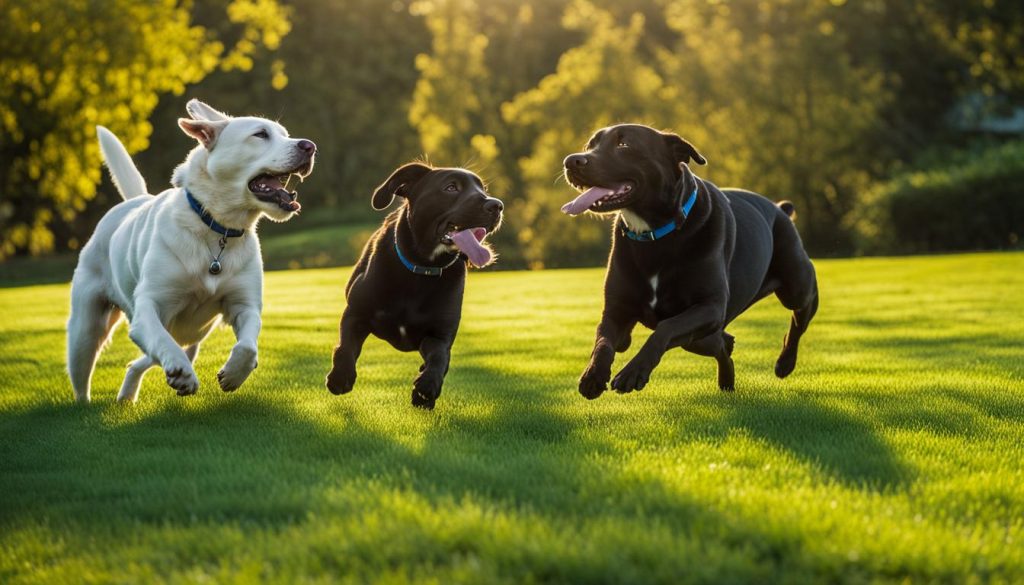Labradors and Pitbulls are popular breeds in the United States, each with its own unique traits and characteristics. When choosing a dog for your family, understanding the differences between these breeds is crucial. In this guide, I will compare Labrador Retrievers and Pitbulls in terms of their temperament, size, strength, intelligence, behavior, training, characteristics, and health.
Labradors are known for their friendly, obedient, and intelligent nature. They are great companions and excel in various activities such as service work and canine sports. On the other hand, Pitbulls are strong, protective, and loyal. Originally bred for fighting purposes, they have transitioned to become companions and family pets.
Now, let’s dive deeper into the specific differences and similarities between Labrador Retrievers and Pitbulls, to help you make an informed decision about which breed is best suited for your family.
Key Takeaways:
- Labradors and Pitbulls have distinct temperaments and characteristics.
- Labradors are friendly, obedient, and intelligent, while Pitbulls are protective, loyal, and strong.
- Size-wise, Labradors are larger than Pitbulls.
- Both breeds require training, exercise, and care to thrive as family pets.
- Consulting with professionals is important when considering pet ownership or breed selection.
Visual Differences
When comparing Labrador Retrievers and Pitbulls, one of the first things that stands out is their visual appearance. Let’s take a closer look at the size and weight differences between these two breeds.
| Labrador Retriever | Pitbull |
|---|---|
| Average Height | 18-21 inches |
| Average Weight | 35-60 pounds |
| Grooming Needs | Minimal |
Labradors are generally larger in size compared to Pitbulls. They typically have an average height ranging from 21½–24½ inches and a weight ranging from 55–80 pounds. In contrast, Pitbulls have an average height of 18–21 inches and a weight between 35–60 pounds. This significant difference in size can be visually observed when comparing the two breeds side by side.
Another aspect to consider is grooming needs. Labradors have a moderate grooming requirement due to their thick coat, which requires regular brushing to prevent matting. On the other hand, Pitbulls have short coats that are easy to maintain, requiring minimal grooming. The difference in grooming needs can be a factor to consider for individuals who prefer a breed with lower maintenance requirements.
Although visual differences play a role in distinguishing these breeds, remember that their physical appearances are just one aspect to consider. The temperament, exercise needs, and overall suitability to individual lifestyles are equally important factors to evaluate when choosing between a Labrador Retriever and a Pitbull.
Labrador Retriever Overview
The Labrador Retriever is a popular breed known for its friendly and playful temperament. Originally bred as retrieving gun dogs, Labradors are highly intelligent and obedient, which makes them great service animals. They are also excellent family pets, known for their affectionate nature and compatibility with children.
Labrador Retrievers have a life expectancy of 10-12 years and require proper care to ensure their well-being. Like all breeds, they are susceptible to certain health conditions. Labradors are prone to hip and elbow dysplasia, which affects the joints, and various eye conditions such as cataracts and progressive retinal atrophy. Regular vet check-ups and a balanced diet are essential for maintaining their health.
In terms of grooming, Labradors have a moderate grooming requirement due to their thick double coat. Regular brushing helps keep their coat clean and healthy, while occasional bathing is sufficient to keep them smelling fresh. Their weather-resistant coat also provides protection from the elements.
| Labrador Retriever Overview | |
|---|---|
| Average Life Expectancy | 10-12 years |
| Temperament | Friendly, playful, and affectionate |
| Health Concerns | Hip and elbow dysplasia, eye conditions |
| Grooming Needs | Moderate grooming, regular brushing, occasional bathing |
Labradors are an active breed and require regular exercise to keep them mentally and physically stimulated. They enjoy activities such as swimming, fetching, and long walks. Their intelligence and willingness to please make them highly trainable, and they excel in various canine sports such as obedience, agility, and search and rescue.
In summary, Labrador Retrievers are friendly, intelligent, and versatile dogs that make excellent companions for active families. With proper care, training, and exercise, they can thrive in various environments and provide love and loyalty to their owners.

Pitbull Overview
The Pitbull breed has a rich and sometimes controversial history. Originally bred for bull-baiting and bear-baiting in 19th-century England, Pitbulls were fierce and aggressive fighters. However, in the early 20th century, they transitioned to become loyal and protective family pets. Today, Pitbulls are known for their strength, athleticism, and loyalty.
When it comes to temperament, Pitbulls can be incredibly loving and affectionate towards their families. They are known to form strong bonds with their owners and are often described as eager to please. Additionally, Pitbulls have a natural protective instinct, making them excellent guard dogs. However, they require proper socialization and training to ensure they are well-behaved around other animals and strangers.
In terms of health, Pitbulls are generally a healthy breed. However, they are prone to certain conditions such as hip dysplasia, which is a common joint disorder in dogs. They may also experience skin allergies, so regular grooming and preventative care are essential. With proper nutrition and regular exercise, Pitbulls can lead long and healthy lives.
Table: Pitbull Breed Overview
| Aspect | Description |
|---|---|
| Breed History | Originally bred for bull-baiting and bear-baiting in 19th-century England, Pitbulls transitioned to become loyal and protective family pets in the early 20th century. |
| Temperament | Pitbulls are loving, affectionate, and protective. They form strong bonds with their families and require proper socialization and training. |
| Health | Pitbulls are generally healthy but may be prone to conditions such as hip dysplasia and skin allergies. Regular grooming and preventative care are important. |
| Care | Pitbulls require regular exercise, proper nutrition, and mental stimulation. They thrive in homes with active owners who can provide them with the attention and structure they need. |
Differences in Temperament
When comparing the temperament of Labrador Retrievers and Pitbulls, both breeds have distinct characteristics and behaviors. Labradors are known for their friendly and gentle nature, making them excellent family dogs. They are typically good with children and other animals, and their playful demeanor adds to their overall appeal. Labradors are highly sociable and love to be part of the family, often seeking attention and affection.
Pitbulls, on the other hand, have a reputation for being protective and loyal to their owners. They are known to form strong bonds with their families and can be fiercely protective when it comes to their loved ones. While Pitbulls can be affectionate and loving, they require proper socialization and training from an early age. Pitbull owners should ensure that their dogs are exposed to different people, animals, and environments to prevent any undesirable behaviors.
Table: Temperament Comparison
| Labrador Retriever | Pitbull | |
|---|---|---|
| Temperament | Friendly, gentle, and sociable | Protective, loyal, and strong-willed |
| Behavior | Playful, seeks attention and affection | Fiercely protective, requires socialization |
| Interaction with Children | Usually good, gentle with kids | Can be good, but supervision is important |
| Interaction with Other Animals | Usually good, gets along with other pets | Requires proper socialization and training |
individual temperament can vary within each breed, and factors such as training, socialization, and environment play a significant role in shaping a dog’s behavior. Responsible ownership, early training, and positive reinforcement are key to ensuring a well-balanced and well-behaved dog, regardless of the breed.
Exercise and Training
Exercise and training are crucial for the physical and mental well-being of both Labrador Retrievers and Pitbulls. These breeds are known for their energy and need for regular activity. Proper exercise helps prevent behavioral issues and promotes overall health and happiness.
Labrador Retriever Exercise Needs: Labrador Retrievers are highly energetic dogs that require at least 1+ hour of exercise per day. They enjoy activities like running, swimming, and playing fetch. Labradors thrive in an environment where they can engage in both physical and mental stimulation, such as agility training or obedience competitions.
Pitbull Exercise Needs: Pitbulls are also active dogs that need similar exercise requirements as Labradors. They require regular walks, vigorous play sessions, or activities that allow them to burn off their energy. Pitbulls excel in activities like weight pulling, flyball, or dock diving. Regular exercise helps prevent boredom and destructive behaviors.
Training
When it comes to training, Labradors are highly trainable due to their intelligence and eagerness to please. They are quick learners and excel in obedience training. Labradors respond well to positive reinforcement techniques and thrive in structured training environments.
Pitbulls, on the other hand, may require more effort and consistency in training. They are known for their strong-willed nature and determination. Pitbulls can be independent thinkers, so you should establish yourself as a confident and consistent leader during training sessions. Positive reinforcement methods work best with Pitbulls, focusing on rewards and praise.
Both breeds benefit from early socialization and obedience training. It helps them become well-rounded and well-behaved dogs. Training should be a positive and enjoyable experience, creating a strong bond between the dog and the owner.

| Labrador Retriever | Pitbull | |
|---|---|---|
| Exercise Needs | At least 1+ hour of exercise per day | Similar exercise requirements as Labradors |
| Training | Highly trainable, quick learners, respond well to positive reinforcement | May require more effort and consistency, respond well to positive reinforcement |
| Recommended Activities | Running, swimming, playing fetch, agility training, obedience competitions | Regular walks, vigorous play sessions, weight pulling, flyball, dock diving |
In summary, both Labrador Retrievers and Pitbulls require regular exercise to keep them physically and mentally stimulated. Labradors need at least 1+ hour of exercise per day, while Pitbulls have similar exercise requirements. Proper training is essential for both breeds, with Labradors being highly trainable and responsive to positive reinforcement, and Pitbulls requiring consistency and confident leadership. Engaging in activities that match their energy levels and interests will help keep them happy and well-adjusted companion animals.
Health Concerns
When considering Labrador Retrievers and Pitbulls as potential pets, be aware of their specific health concerns. Both breeds are prone to certain conditions that can affect their overall well-being and lifespan.
Labrador Retriever Health Issues:
Labradors have an average lifespan of 10-12 years. While they are generally healthy dogs, there are a few common health issues that they may be susceptible to. These include:
- Hip and elbow dysplasia: Labradors can be prone to these joint conditions, which can cause pain and mobility issues.
- Various eye conditions: Labradors can develop conditions such as cataracts, progressive retinal atrophy, and glaucoma, which can affect their vision.
- Obesity: Labradors have a tendency to gain weight easily, so monitor their diet and provide regular exercise to prevent obesity-related health issues.
Pitbull Health Issues:
Pitbulls have a longer average lifespan of 12-16 years. While they are generally healthy dogs, there are a few health issues that they may be prone to. These include:
- Hip dysplasia: Pitbulls can develop hip dysplasia, which is a condition where the hip joint doesn’t fit properly, causing pain and mobility issues.
- Skin allergies: Pitbulls can be prone to allergies, which can manifest as skin irritations, itching, and rashes. Proper grooming and a balanced diet can help manage these allergies.
- Heart conditions: Some Pitbulls may be susceptible to heart conditions such as cardiomyopathy, which can affect their heart function and overall health.
Regular veterinary check-ups, a balanced diet, and proper exercise are essential for both Labrador Retrievers and Pitbulls to maintain optimum health and prevent the onset of these conditions.

Table: Overview of Health Concerns in Labrador Retrievers and Pitbulls
| Health Concerns | Labrador Retrievers | Pitbulls |
|---|---|---|
| Hip Dysplasia | Common | Common |
| Elbow Dysplasia | Common | |
| Eye Conditions | Cataracts, Progressive Retinal Atrophy, Glaucoma | |
| Obesity | Prone | |
| Skin Allergies | Prone | |
| Heart Conditions | Cardiomyopathy |
Grooming Needs
Proper grooming is essential for maintaining the health and appearance of your Labrador Retriever or Pitbull. While both breeds have different coat types and grooming requirements, keeping them clean and well-groomed will contribute to their overall well-being.
Grooming for Labrador Retrievers
Labradors have a dense, water-resistant double coat that requires regular brushing to prevent matting and minimize shedding. A slicker brush or a grooming glove can effectively remove loose hair and distribute the natural oils in their coat. They shed moderately throughout the year and have heavier shedding periods during spring and fall.
In addition to brushing, Labradors should have their ears checked regularly for signs of infection and cleaned as needed. Their nails should be trimmed regularly to maintain proper foot health, and dental hygiene should be maintained through regular brushing or dental chews.
Grooming for Pitbulls
Pitbulls have short, smooth coats that are low-maintenance and easy to groom. Regular brushing with a soft bristle brush or a grooming mitt will help keep their coat shiny and remove any loose hair. Pitbulls are moderate shedders and may require more frequent brushing during shedding seasons.
Similar to Labradors, Pitbulls should have their ears checked and cleaned regularly to prevent infections. Their nails should be trimmed regularly, and dental hygiene should also be maintained through proper brushing or dental treats.
| Grooming Needs | Labrador Retriever | Pitbull |
|---|---|---|
| Coat Type | Double coat, dense, and water-resistant | Short, smooth coat |
| Brushing | Regular brushing to prevent matting and minimize shedding | Regular brushing to keep the coat shiny and remove loose hair |
| Shedding | Moderate throughout the year with heavier shedding during spring and fall | Moderate shedding |
| Ears | Regular cleaning to prevent infections | Regular cleaning to prevent infections |
| Nails | Regular trimming for proper foot health | Regular trimming for proper foot health |
| Dental Hygiene | Regular brushing or dental chews | Regular brushing or dental treats |
Overall, both Labradors and Pitbulls require regular grooming to keep them healthy and looking their best. Understanding their specific grooming needs and dedicating time for grooming sessions will help ensure that your furry companion remains comfortable and happy.

Suitable for Labrador Retrievers and Pitbulls
Labrador Retrievers and Pitbulls are two popular breeds with distinct characteristics, making them suitable for different types of owners and households. Whether you’re looking for a family-friendly dog or a highly trainable companion, understanding the suitability of each breed can help you make an informed decision.
Families and Children
Labrador Retrievers are known for their friendly and gentle nature, making them an excellent choice for families with children. They are patient, playful, and make great companions for kids of all ages. Pitbulls, on the other hand, can also be family-friendly when properly trained and socialized from an early age. While they are generally loyal and protective, please provide consistent training and supervision around children to ensure their safety.
Trainability
Labrador Retrievers are highly trainable due to their intelligence and eager-to-please nature. They excel in obedience training and can easily learn new commands and tricks. Pitbulls, while intelligent, may require more effort and consistent training due to their strong-willed nature. With proper training techniques and positive reinforcement, Pitbulls can become well-behaved and obedient companions.
| Labrador Retriever | Pitbull | |
|---|---|---|
| Family-Friendly | Yes | Yes (with proper training and socialization) |
| Trainability | Highly trainable | Requires consistent training |
Exercise and Activity Levels
Both Labrador Retrievers and Pitbulls are energetic breeds that require regular exercise to stay happy and healthy. Labradors, being bred as retrieving dogs, have a higher energy level and need at least 1+ hour of exercise per day. They enjoy activities like swimming, playing fetch, and long walks. Pitbulls, although slightly smaller in size, also require a similar amount of exercise to burn off their energy. Engaging them in interactive games and vigorous exercise will keep them mentally and physically stimulated.
Overall, both Labrador Retrievers and Pitbulls can make wonderful companions, each with their own unique qualities. Consider your lifestyle, experience, and the specific needs of each breed before making your choice. I highly suggest that you provide proper training, exercise, and socialization to ensure a happy and harmonious relationship with your furry friend.

Final Thoughts
After comparing Labrador Retrievers and Pitbulls across various aspects, it is clear that both breeds have unique characteristics and considerations. Labradors are friendly, obedient, and intelligent dogs, making them well-suited for families looking for a trainable and loyal companion. Pitbulls, on the other hand, are strong, protective, and loyal, making them ideal for experienced owners who desire a dedicated and protective pet.
When it comes to size, Labradors are generally larger than Pitbulls, with Labradors weighing between 55-80 pounds and Pitbulls weighing between 35-60 pounds. Labradors also have a longer life expectancy of 10-12 years, while Pitbulls can live up to 12-16 years.
Temperament-wise, Labradors are known for being friendly, gentle, and family-oriented dogs. They easily get along with children and other animals. Pitbulls, on the other hand, can be more aggressive and protective. Proper socialization and training are crucial for both breeds to ensure positive interactions with other animals and strangers.
In terms of exercise and training, both breeds require regular exercise to stay healthy and happy. Labradors need at least 1 hour of exercise per day while Pitbulls need a similar amount. Labradors are highly trainable due to their intelligence and obedience, whereas Pitbulls may require more effort and consistency in training.
Overall, the decision between a Labrador Retriever and a Pitbull depends on an individual’s lifestyle, experience, and preferences. You should thoroughly research and consider the needs and characteristics of each breed before making a decision. Consulting with a veterinarian or professional dog trainer can also provide valuable guidance in selecting the right breed for your family.
Featured Image Credit

If you’re looking for an eye-catching visual representation of the Labrador Retriever vs. Pitbull comparison, look no further than the featured image credit provided by Jumpstory. This stunning image captures the essence of these two popular dog breeds and serves as a captivating introduction to the article.
Featuring a Labrador Retriever and a Pitbull side by side, this image highlights the distinct physical characteristics of both breeds. The Labrador Retriever’s friendly and intelligent expression contrasts with the Pitbull’s strong and protective stance, showcasing the unique traits that define each breed.
With this visually engaging image, readers can get a glimpse of the Labrador Retriever and Pitbull’s appearance, setting the stage for a deeper exploration of their differences in temperament, exercise and training needs, health concerns, grooming requirements, and suitability for different households.
Disclaimer
The information provided in this article is for informational purposes only and should not be considered as professional advice. As a copywriting journalist, I aim to provide accurate and up-to-date information about Labrador Retrievers and Pitbulls. However, you should consult with a veterinarian or professional dog trainer before making any decisions regarding pet ownership or breed selection.
Every dog is unique, and individual characteristics may vary within a breed. Factors such as genetics, environment, and training can all influence a dog’s behavior, health, and temperament. Therefore, it is essential to conduct thorough research and gather expert opinions to make informed decisions about the suitability of Labrador Retrievers or Pitbulls for your specific circumstances.
I cannot guarantee the accuracy or completeness of the information presented in this article, as new research and developments regarding these breeds may arise. It is advisable to consult multiple sources and gather a comprehensive understanding of Labrador Retrievers, Pitbulls, and any specific breed traits or considerations that may be relevant to your situation.
FAQ
What are the average sizes of Labradors and Pitbulls?
Labradors are larger than Pitbulls, with average heights ranging from 21½–24½ inches and weights ranging from 55–80 pounds. Pitbulls have average heights of 18–21 inches and weights between 35–60 pounds.
What grooming needs do Labradors and Pitbulls have?
Labradors have moderate grooming needs due to their thick coat, which requires regular brushing. Pitbulls, on the other hand, have short coats that are easy to maintain and require minimal grooming. Regular brushing and occasional bathing are sufficient for Pitbulls.
What are the typical temperaments of Labradors and Pitbulls?
Labradors are known for being friendly, gentle, and family-oriented. They get along well with children and are not typically aggressive towards other animals. Pitbulls can be more aggressive and protective of their owners, requiring proper socialization and training.
How much exercise do Labradors and Pitbulls need?
Labradors need at least 1+ hour of exercise per day, while Pitbulls also require a similar amount of exercise. Both breeds are energetic and require regular physical activity to stay healthy and happy.
What are the common health issues for Labradors and Pitbulls?
Labradors are prone to conditions such as hip and elbow dysplasia, as well as various eye conditions. Pitbulls can suffer from hip dysplasia, skin allergies, and heart conditions. Regular vet check-ups and proper care are important for both breeds.
Which breed is more suitable for families with children?
Labradors are known to be family-friendly and get along well with children. They have a friendly and gentle temperament that makes them great companions for families. Pitbulls can also be suitable for families but require proper training and socialization due to their protective nature.
Are Labradors and Pitbulls easy to train?
Labradors are highly trainable due to their intelligence and obedience. They are quick learners and excel in various training activities. Pitbulls may require more effort and consistency in training but can also be trained to be well-behaved and obedient.
What type of owners are Labradors and Pitbulls suitable for?
Labradors are best suited for active families looking for a friendly and trainable dog. They are great for families with children and can excel in various canine sports. Pitbulls are suitable for active owners who are experienced in handling and training dogs. They are loyal and protective, making them good companions for individuals who need a personal guard dog.
Are Labradors and Pitbulls good with other animals?
Labradors are generally not aggressive towards other animals and can get along well with them. Pitbulls, on the other hand, may display more aggression towards other animals and require proper socialization and training to behave well around them.
What is the life expectancy of Labradors and Pitbulls?
Labradors have a life expectancy of 10-12 years, while Pitbulls have a longer lifespan of 12-16 years. Proper care, nutrition, and regular vet check-ups are important for both breeds to live a long and healthy life.
How much grooming do Labradors and Pitbulls need?
Labradors have moderate grooming needs due to their thick coat, which requires regular brushing. Pitbulls, on the other hand, have short coats that are easy to maintain and require minimal grooming. Regular brushing and occasional bathing are sufficient for Pitbulls.






